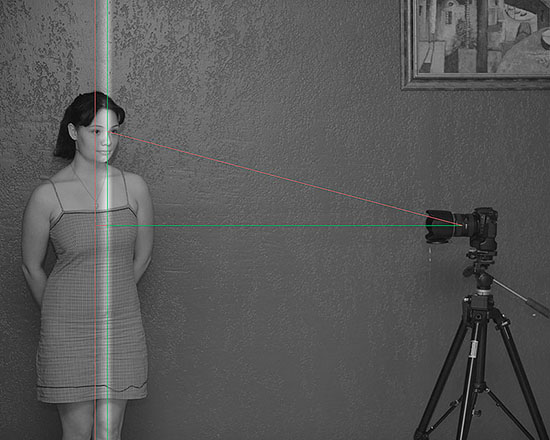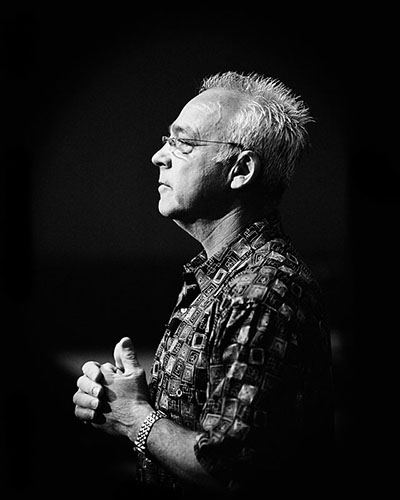In most modern SLR cameras, the autofocus
sensor located at the center of the frame is generally designed to
be more sensitive and more accurate than most or all of the camera's
other AF sensors. In low-light situations, it is possible for the center
AF sensor to be the only one that will reliably lock on to the subject
and achieve focus lock. This has given rise to the technique of center
point focus-recompose, which involves placing the center AF sensor
on the portion of the subject that needs to be the most clearly focused,
and activating autofocus. Once focus has been achieved, then the camera
is reoriented until the desired framing is achieved, and then the shutter
is released. There's just one problem with this idea: it is 100% guaranteed
to cause focus to be behind the intended center of focus.
To understand why, one needs to understand some basics of modern lens
design. The vast majority of lenses are designed so that the center
of focus lies on a plane parallel to the film/sensor plane of the camera.
The distance between the plane of sharpest focus and the film/sensor
plane will (approximately) match the distance marked on the lens barrel.
Testing your lens to see if it behaves this way is easy; simply point
it directly at a brick wall so that it is perpendicular to the wall
vertically and horizontally. Focus on the wall. If the entire wall
is in focus, your lens has the standard planar field of focus. If a
circular or doughnut shaped area of the wall is in focus, your lens
has a curved field of focus and is very unusual. Or else it is defective.
Or a really cheap piece of crap. But I digress.
If you are in the vast majority of photographers with a lens that
focuses along a plane, you need to realize that if your lens is set
to focus at 6 feet, that does NOT mean that all objects 6 feet away
from the lens will be in focus. Instead, it means that all objects
lying on a plane parallel to and 6 feet away from the film/sensor plane
will be in focus. When you focused on the brick wall and had all of
the bricks in focus simultaneously, were all of the bricks in the wall
the same distance from the lens? Nope. If you parked the camera on
a tripod and measured brick-to-lens distances, you would find that
the at the edges of the wall are considerably more distant than the
bricks in the center of the wall. But they are still all in focus,
and that's where focus-recompose causes problems. In the photo below,
I have diagrammed a fairly typical profile portrait setup. The vertically
highlighted area represents the zone that should be the most clearly
focused. The green vertical line represents the correct distance setting
necessary to achieve that focus.

In this example, the correct distance setting is 6.456
feet, represented by the horizontal green line. If the camera is reoriented
so that the center AF sensor focuses on the correct spot between the
subject's eyes, focus distance will be set at 6.679 feet, represented
by the diagonal red line. This will result in the focus distance being
set 2.676 inches farther out than the correct distance, which means
that when the camera is tilted back to achieve correct framing, the
center of focus will be along the vertical red line instead of the
vertical green line where it belongs. If the camera was tilted up by
tilting the tripod head back, the error would be increased another
few inches, since the camera would be moving away from the subject
an additional few inches as it was tilting up. The setup pictured above
would approximately double the focus error amount previously mentioned.
Your mileage will vary, depending on the configuration of your tripod
head.
When shooting a portrait at a wide aperture, 2-3 inches of focus error
can make the difference between just right and just crap. Here's an
example; it was shot with a 100mm f/2 lens wide open. Depth of field
is about 2 inches, maybe less, look closely at the back of the left
hand and the designs on the shirt and you will see how narrow it really
is:

To make this portrait, I manually selected the rightmost
AF sensor on my Canon 1Ds (which ended up on top when I rotated the
camera vertically to take the shot) and autofocused on the subject's
left eye. Using this technique, I did not reorient the camera between
focusing and exposure. If I had used the center AF sensor instead and
had to recompose after focusing, focus would have been centered slightly
behind the subject's nose and the shot would have been ruined, unacceptably
out of focus.
The error introduced by focus-recompose is greater with shorter camera-to-subject
distances. If you are using a telephoto lens and focus-recompose on
a football coach on the other side of the field, the error introduced
would only be a small fraction of an inch and would be dwarfed by many
other factors such as subject movement, photographer movement, and
the fact that depth of field at 50+ yards distance is usually at least
a few feet; even an inch of error in that case is about as significant
as a fart in a tornado. But when shooting portraits at close range
with wide apertures and the resulting narrow depth-of-field, it can
really cause problems. If you focus-recompose in such conditions and
get consistently back-focused shots, your camera's autofocus calibration
is probably just fine. It's your bad technique that most likely the
real culprit.
It is far better to use a less sensitive/less accurate autofocus sensor
on the edge of the frame that will at least attempt to set the correct
focus distance than to use the more accurate center sensor that is
guaranteed to focus behind where you intended.
Here is Jonathan Wienke's website.
|